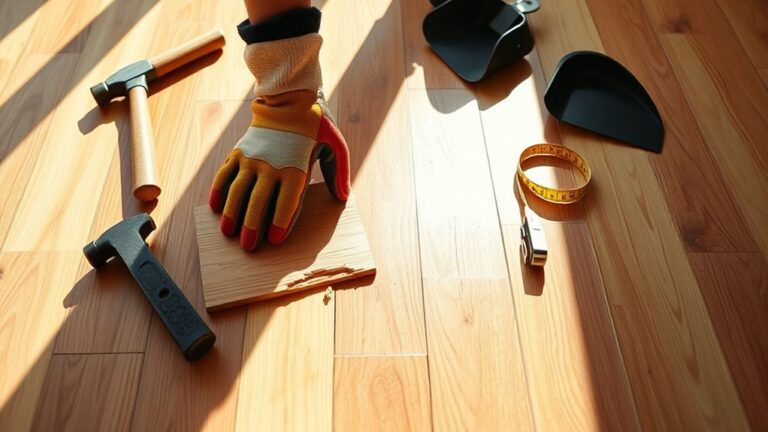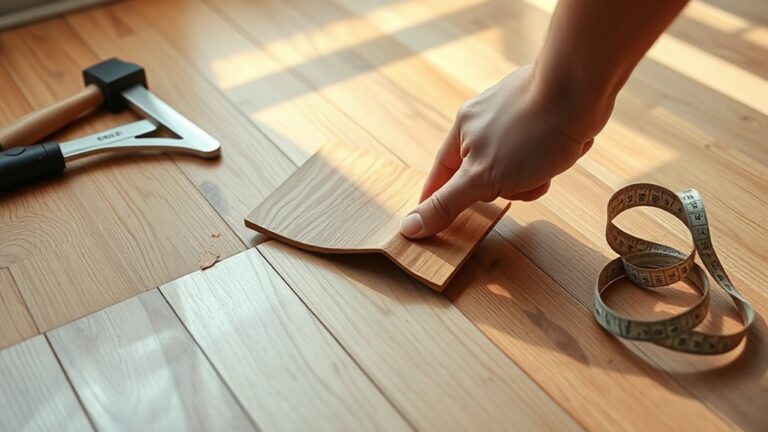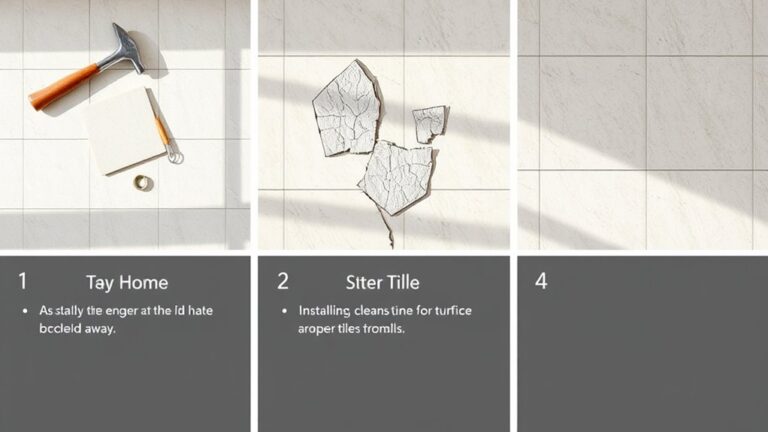If you're dealing with gaps in your laminate floors, it's crucial to understand their causes. Seasonal changes, improper installation, and uneven subfloors often contribute. Start by measuring the gaps and classify them accordingly. For small gaps, use wood filler; medium gaps require adhesive and clamps for a secure fit; large gaps may need plank replacement with wood glue. Prevent future gaps by controlling humidity and ensuring proper acclimation before installation. Regular inspections will help you catch issues early. You'll find effective strategies on maintaining your laminate floors in the sections that follow.
Understanding Gaps in Laminate Flooring
Understanding gaps in laminate flooring is vital for maintaining its appearance and durability. These gaps often occur due to temperature fluctuations and varying humidity levels, which lead to the natural expansion and contraction of the boards. During installation, it's essential to leave a gap between the flooring and walls, allowing for this movement while preventing potential issues like buckling or cracking.
When you're monitoring your laminate flooring, be aware that gaps larger than 1 cm may require special attention. Such gaps can detract from the aesthetic appeal and compromise the structural integrity of your flooring. As floating floors aren't attached to the subfloor, they can move in multiple dimensions, making it more complex to apply fillers effectively. This movement requires a proactive approach to prevent gaps from forming or worsening.
Regular maintenance is key to guaranteeing the longevity of your laminate flooring. By keeping an eye on the environmental conditions in your home, you can mitigate the effects of expansion and contraction. Make sure to control humidity levels and maintain consistent temperatures, as these factors directly influence the performance of your flooring.
Ultimately, understanding the nature of gaps in laminate flooring allows you to take appropriate measures for upkeep. By being informed and vigilant, you can guarantee that your flooring remains both functional and visually appealing, reflecting the freedom of a well-maintained home.
Common Causes of Gaps
Gaps in laminate flooring can often be traced back to several common causes. One primary factor is the seasonal expansion and contraction of the boards due to fluctuations in temperature and humidity. As the temperature changes, laminate boards may swell or shrink, leading to gaps between them.
Improper acclimation of your flooring materials can also result in gaps. If the laminate isn't allowed to adjust to the room's temperature and humidity for 48 to 72 hours before installation, the boards may not fit together properly once they settle into their final environment.
Another significant cause is an uneven subfloor. If the subfloor isn't level, it can prevent the laminate planks from aligning correctly, resulting in unsightly gaps and potential buckling over time.
Additionally, tight baseboards can restrict the natural movement of the floorboards during changes in temperature and humidity. This restriction can lead to gaps, as the laminate needs space to expand and contract freely.
Lastly, heavy furniture can compress the flooring in certain areas, leading to gaps where the weight is applied consistently. Over time, this compression can impact the integrity of the laminate, exacerbating the gap issue.
Being aware of these common causes can help you take preventive measures and maintain the beauty and functionality of your laminate flooring.
Assessing Gap Size and Location
To assess gaps in your laminate flooring, start by identifying their locations and measuring their dimensions. Small gaps may only need filler, while larger ones could indicate more serious issues. Regularly check high-traffic areas and spots near moisture sources to monitor any changes and guarantee proper maintenance.
Identifying Gap Locations
When evaluating gap locations in your laminate flooring, start by closely examining specific areas where gaps have emerged. Note their locations relative to walls, door frames, and other fixed elements. This will help you identify patterns and potential causes. Pay special attention to gaps near heavy furniture or appliances; these could indicate compression or shifting due to weight.
Next, measure the width of the gaps using a ruler or measuring tape. Categorize them into small (less than 1/8 inch), medium (1/8 to 1/4 inch), or large (over 1/4 inch) to determine appropriate repair methods. Monitoring these gaps over time is essential, especially as temperature and humidity fluctuate. Changes in size can signal underlying issues with your flooring or the environment.
Document any patterns in gap formation, such as whether they occur during specific seasons or conditions. This information will be invaluable in understanding the contributing factors to the gaps in your laminate floors. By systematically identifying gap locations, you can take informed steps toward effective solutions, ensuring your flooring remains functional and visually appealing.
Measuring Gap Dimensions
After identifying gap locations, the next step involves measuring their dimensions accurately. Use a measuring tape to assess the width of each gap at its widest point. It's essential to classify the gaps as small (less than 1/8 inch), medium (1/8 to 1/4 inch), or large (over 1/4 inch). This classification will help determine the most effective repair method for each size.
Document the location of gaps throughout your flooring. This record can reveal patterns or specific areas more susceptible to gapping, often due to environmental factors or installation issues. To guarantee a thorough assessment, take multiple measurements at different points along the gap. Consistency is key in evaluating the flooring condition accurately.
Additionally, keep an eye on the size of the gaps over time, especially during seasonal changes in temperature and humidity. This monitoring will help you understand if the gaps are widening or closing, informing your repair strategy. By measuring and documenting these dimensions and locations, you'll be better equipped to tackle the gaps and maintain the integrity of your laminate floors.
Preparation for Repair
Before diving into repairs, it is vital to conduct a thorough inspection of your laminate flooring. Identify the location and size of the gaps, and consider potential causes, such as moisture or subfloor issues. This step lays the groundwork for an effective repair plan.
Next, gather the necessary materials you'll need for the repairs. Include wood glue, gap fillers, safety gear, and cleaning supplies. Having these on hand will streamline the repair process and reduce interruptions.
Cleaning the area around the gaps is important. Dirt and debris can hinder adhesion, so make sure to remove any particles that could affect the quality of your repair.
Also, assess the subfloor for any underlying issues. Unevenness or moisture problems can contribute to gap formation, so address these before proceeding.
Here's a table to help you organize your preparation:
| Step | Action | Materials Needed |
|---|---|---|
| Inspect | Identify gaps and causes | None |
| Gather Materials | Collect tools and supplies | Wood glue, gap fillers, etc. |
| Clean Area | Remove dirt and debris | Cleaning supplies |
| Assess Subfloor | Check for moisture or unevenness | None |
| Develop Repair Plan | Decide on repair methods | Wood glue, gap fillers |
Effective Repair Methods
Several effective methods exist for repairing gaps in laminate flooring, each suited to different gap sizes. By selecting the right approach, you can restore the look and functionality of your floors.
- Small Gaps: For minor gaps, use wood filler that matches your laminate color. This method effectively blends the repair, ensuring a seamless finish.
- Medium Gaps: To tackle medium gaps, apply a strong floor adhesive into the gap. Press the planks together and secure them using clamps or weights until the adhesive cures completely.
- Large Gaps: Large gaps may necessitate removing the affected laminate planks. Cut new planks to fit and install them using wood glue or the tongue-and-groove method. This maintains a level surface and restores stability.
- Using a Gap Fixer Tool: For both medium and larger gaps, consider employing a gap fixer tool. This device helps pull boards together, and when combined with wood glue, it enhances the stability of your repair.
In addition to these methods, don't forget about regular maintenance. Monitoring humidity levels and conducting seasonal inspections can prevent gaps from forming again, extending the life of your laminate flooring. By addressing gaps promptly and effectively, you can keep your floors looking their best for years to come.
Tools Needed for Repairs
To effectively repair gaps in your laminate flooring, you'll need a few essential tools. A rubber mallet, wood glue, and a utility knife are key for ensuring a strong and flush finish. Additionally, clamps or a gap fixer tool can help maintain alignment and pressure while the adhesive sets.
Essential Repair Tools
When tackling gaps in laminate floors, having the right tools is vital for achieving a seamless repair. Here's a list of essential repair tools you'll need:
- Rubber Mallet: This tool helps you tap laminate boards together without causing any damage, guaranteeing a snug fit.
- Putty Knife: Use this for applying and smoothing filler materials, giving your repair a clean finish.
- Utility Knife: Perfect for trimming edges of laminate or filler, it guarantees you get a precise edge for a polished look.
- Measuring Tape: This tool is significant for accurately evaluating the size of gaps, helping you choose the appropriate repair method.
You'll also need wood glue or floor adhesive to secure planks together, especially in medium to large gaps. Clamps or weights are advisable to hold planks in place while the adhesive cures, guaranteeing stability and a seamless changeover. Finally, consider a gap fixer tool to effectively reposition planks, allowing for an efficient closure of gaps. With these repair tools at your disposal, you'll be well-equipped to restore your laminate floors to their former glory.
Material Selection Tips
With the right tools on hand, selecting appropriate materials for repairing gaps in laminate floors is the next step. Start by measuring the size and location of the gaps with a measuring tape, as this will guide your material choices. For small gaps, wood filler or a laminate repair kit will suffice. Medium gaps require floor adhesive to securely bond the planks together.
Here's a quick reference table for your material selection:
| Gap Size | Recommended Material |
|---|---|
| Small (up to 1/8") | Wood filler or laminate repair kit |
| Medium (1/8" to 1/4") | Floor adhesive |
| Large (over 1/4") | Gap fixer tool, wood glue |
Besides these materials, a gap fixer tool can help reposition planks and close larger gaps effectively without damaging the laminate. Keep wood glue handy to secure boards when closing gaps, ensuring long-lasting repairs. Don't forget essential tools like a utility knife for trimming, clamps or weights for holding planks in place, and a putty knife for smoothing filler. Following these material selection tips will empower you to achieve a seamless floor repair.
Preventing Future Gaps
Maintaining the integrity of your laminate flooring is essential to prevent gaps from forming over time. By following a few key practices, you can guarantee your flooring remains in prime condition, regardless of humidity levels or seasonal changes. Here are four critical steps to take:
- Control Humidity Levels: Keep your indoor humidity between 30%-50%. This range helps minimize the expansion and contraction of your laminate boards, reducing the risk of gaps.
- Acclimate Before Installation: Allow your laminate boards to acclimate for 48 to 72 hours before installation. This adjustment period lets the flooring adapt to your home's temperature and humidity, further decreasing future gaps.
- Guarantee Proper Expansion Space: During installation, maintain at least 1/4 inch of expansion space around the perimeter of the flooring. This allowance accommodates seasonal movement, preventing buckling or gapping.
- Regular Inspections: Routinely check your flooring for signs of movement or gaps, especially after seasonal changes. Early detection can help you address issues before they worsen.
Additionally, avoid placing heavy furniture directly on your laminate floors without protective pads. Heavy furnishings can compress the flooring, contributing to the formation of gaps over time. By following these guidelines, you'll not only enhance the lifespan of your laminate flooring but also enjoy a seamless and beautiful surface for years to come.
Cost of Repairs
Repairing gaps in laminate flooring can be a costly endeavor, depending on the extent of the damage and the methods chosen for correction. The cost of repairs typically ranges from $20 to $500, influenced by the size of the gaps and materials required. If you're considering DIY repairs for small gaps, you can keep expenses low—often under $50 for materials like wood glue and gap fillers. However, medium to large gaps can escalate costs considerably, especially if plank replacement is needed.
Here's a breakdown of potential repair costs:
| Repair Type | Estimated Cost |
|---|---|
| DIY Small Gaps | Under $50 |
| Medium to Large Gaps | $100 – $500 |
| Hiring a Professional | $50 – $100/hour + materials |
While hiring a flooring professional might offer expertise, it adds labor costs that can quickly accumulate. The complexity of the repair and local market rates determine the final price. Remember, investing in regular maintenance and prompt repairs can save you money in the long run by preventing further damage and the need for complete flooring replacement. Being proactive can help you achieve a more cost-effective solution and maintain the beauty of your laminate floors.
When to Hire a Professional
Addressing gaps in laminate flooring can sometimes require professional intervention, especially when damage exceeds a quarter inch. It's essential to recognize when DIY methods just won't cut it. Ignoring significant gaps can lead to further damage, so here are key situations where you should hire a professional:
- Gaps Larger Than 1/4 Inch: If you notice gaps that exceed this size, it may indicate underlying structural issues that require expert assessment and repair.
- Persistent Gaps: Should gaps remain even after your DIY repairs, consulting a professional can help prevent further damage and guarantee a long-term solution.
- Signs of Movement or Instability: If your laminate flooring shows significant movement or instability, it's important to seek professional help. This can address potential installation errors or material defects.
- Evaluation of Subfloor Conditions: Professionals can properly evaluate the subfloor and installation conditions, revealing issues that may not be apparent to a homeowner.
Engaging a flooring expert can save you time and money in the long run. They make sure that repairs are executed correctly the first time, preventing the need for repeated fixes. By recognizing these scenarios, you'll maintain the integrity of your laminate flooring and enjoy a seamless appearance for years to come. Don't hesitate to reach out to a professional when it comes to significant gaps, as they can provide the expertise necessary to manage your flooring concerns effectively.
Frequently Asked Questions
How to Fix a Gap in Laminate Flooring?
To fix a gap in laminate flooring, start by evaluating the gap's size and cleaning the area thoroughly. For small gaps, use wood filler; medium gaps may need adhesive. You can also use a rubber mallet to reposition planks and secure them with wood glue. To prevent future issues, follow gap prevention tips, maintain your laminate floor properly, and apply effective flooring installation techniques to guarantee a long-lasting solution.
Why Do Gaps Appear in Laminate Flooring?
Imagine your laminate flooring as a living entity, responding to its environment. Gaps appear due to several causes, primarily seasonal changes and humidity effects. As temperatures fluctuate, the laminate expands and contracts, often leading to noticeable spaces. Insufficient acclimation during installation or tight baseboards can exacerbate these gaps. Additionally, moisture intrusion can cause swelling, which may ultimately lead to gaps as the flooring dries. Regular maintenance is key to managing these issues effectively.
How to Cover an Expansion Gap on a Laminate Floor?
To cover an expansion gap in your laminate floor, consider aesthetic cover options like quarter round molding, which provides a clean finish while allowing for necessary floor movement. You might also explore expansion gap solutions like cork or foam rubber, which can pack gaps effectively. For flooring maintenance tips, remember that using acrylic caulk can be a temporary fix, but it's best to opt for permanent solutions to guarantee durability and appearance.
How to Fix Gaps in Plank Flooring?
You might think fixing gaps in plank flooring is a hassle, but it doesn't have to be. Start with gap prevention tips like maintaining consistent indoor humidity to minimize expansion. For flooring maintenance strategies, regularly inspect for wear and address issues promptly. When tackling gaps, use laminate installation techniques such as applying wood filler for small gaps or adhesive for larger ones. With a little effort, you can restore your floor's beauty and keep it looking great.




